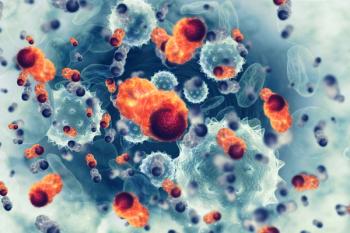
Ziftomenib Elicits Responses in Relapsed/Refractory AML Mutation Subgroups
At the recommended 600 mg dose, ziftomenib interestingly produced complete remissions in patients relapsed/refractory acute myeloid leukemia who harbored NPM1 mutations .
The rate of complete remissions (CR) that occurred following treatment with ziftomenib in patients with NPM1-mutated relapsed/refractory acute myeloid leukemia were a point of interest, as half were also minimal residual disease (MRD) negative, according to Harry Erba, MD.
Erba, a hematologic oncologist at Duke Health, interviewed with CancerNetwork® regarding these findings, which read out as part of the
Transcript:
We had a cohort of 20 patients with NPM1 mutated relapsed/refractory acute myeloid leukemia who were treated with ziftomenib at 600 mg daily. In that population of patients from the phase 1a/1b portion of the study, we saw complete remissions (CR) with full blood count recovery and another patient with a CRi [incomplete hematologic response].
What was interesting is that by local criteria, about half of those remissions were MRD negative. The other thing that was very interesting is that 2 of the patients had concurrent IDH1 and IDH2 mutations and 2 patients had both IDH mutation and a FLT3-ITD or TKD, and were in the complete response group.
On the other hand, we saw a signal for increased differentiation syndrome in the KMT2A-rearrange patients at both the 200 mg and 600 mg doses with only 1 CR in the KMT2A-rearranged patients of the 32 who were treated in the study.
We believe this was due to the early discontinuation of ziftomenib that was due to investigators taking their patients off study treatment due to a rapidly rising white blood cell count or the development of extramedullary disease. In retrospect, we think that many of these patients likely had an exuberant differentiation syndrome, causing the blast increase, as well as this proliferation or increase in extramedullary disease.
For example, in one of my patients for whom I was able to continue the study drug, each of those sites of extramedullary disease went away with continued treatment with ziftomenib without any other antileukemic effect.
We believe that we are seeing this signal for differentiation syndrome and the extramedullary apparent progression of disease due to differentiation because of the high tissue penetration of ziftomenib. [Additionally], patients with KMT2A rearranged AML often have monocytic morphology and a high incidence of extramedullary disease, either clinically or obvious or subclass.
Reference
Erba HP, Fathi AT, Issa GC, et al. Update on a phase 1/2 first-in-human study of the menin-KMT2A (MLL) inhibitor ziftomenib (KO-539) in patients with relapsed or refractory acute myeloid leukemia. Blood. 2022; 140(suppl 1):153-156. doi:10.1182/blood-2022-167412
Newsletter
Stay up to date on recent advances in the multidisciplinary approach to cancer.
















































































